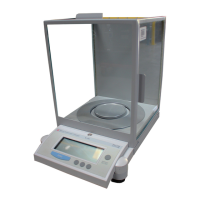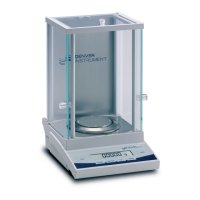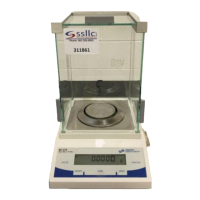Do you have a question about the Denver Instrument PK-Series and is the answer not in the manual?
Modifications not approved by the manufacturer may void user authority to operate this equipment.
Never lift the balance by the weighing pan to prevent damage to internal mechanisms.
Details capacity, readability, repeatability, and pan size for various PK-Series balance models.
Covers dimensions, weight, power, operating temperature, humidity, and calibration for all models.
Highlights portability, weighing pan material, housing construction, keypad, RS232 interface, and leveling feet.
Advice on temperature acclimation, warm-up time, clean environment, and careful handling of the balance.
Ensures correct voltage matching, warns against hazardous locations and liquid contact with the adapter.
Do not open the balance housing; it contains no user-serviceable parts and doing so voids the warranty.
Instructions for connecting and using the balance with an AC adapter, including necessary precautions.
Procedures for battery installation, removal, and replacement based on LCD indicators.
Detailed instructions for calibrating the balance, including required warm-up time and handling during the process.
Explains power-up test, stable reading arrow, overload (H), negative values, auto-off, and lock-down bracket.
Details how to use the tare feature to zero the balance or exclude container weight from measurements.
Describes the functions of the ON/MEMORY, OFF, CAL/MODE, and TARE/PRINT keys for balance control.
Instructions for setting up and using the parts counting feature, including minimum part weight requirements.
Detailed steps for utilizing the memory function for cumulative weighing and viewing total results.
Table of internal menu codes for configuring RS232 parameters like baud rate, parity, and stop bits.
Step-by-step guide on accessing and modifying internal balance parameters using the keypad menu system.
Conditions needed for printing, including correct data interface cable and matching RS-232 settings on devices.
Explanation of how a computer can remotely control balance functions using the RS-232 interface and specific commands.
Table listing remote functions, their effect on the balance, and the corresponding PC control codes for operation.
Diagrams illustrating the PIN configuration for connecting the balance to RS-232 9-PIN and 25-PIN connectors.
Table detailing common display error codes (L, H, LO, E-02, E-10, E-30, E-54, A) with their causes and remedies.
Lists AC adapters, calibration weights, cable locks, carrying cases, and glass draft rings available for the balance.
Instructions for warranty registration, product return procedures, and contact information for Denver Instrument offices.
| Calibration | External |
|---|---|
| Display | LCD |
| Units of Measurement | g, oz, ct, GN, dwt |
| Interface | RS232 |
| Power | AC Adapter |











